The Nanango 1000 Mile Track Race was the perfect way for Eleanor Robinson to mark her 50th birthday.
When Robinson turned 50 in November 1997, she had been an ultrarunner for 16 years. She was a 24 Hour World Champion, 100k World Champion twice and had probably set more world records and world bests than any other ultrarunner1. Robinson wasn’t interested in a 50th birthday party or a holiday2, she was looking for “something out of the ordinary” to celebrate her half century. She had four criteria for her perfect event:
- It had to challenge her
- It had to be an event that she hadn’t done before
- It had to have wider recognition, such as a championship race, and
- She had to do it whilst she was 50
In January 1998, a letter arrived from Peter Warner, the organiser of the 1000 Miles Track Race in Nanango, Queensland, Australia, inviting Robinson to take part in the event.
Was this to be her challenge at 50?
Robinson had taken part in a 1000 mile race before, when in 1987, she raced Malcolm Campbell around Britain in a stage road race where they covered 100k a day, resting at night. Robinson finished first, running 1000 miles in 16 days, 22 hours, 51 minutes, a new world record3. However, her furthest distance in a multi-day race was 538.6 miles when she set a 6 day world best at the Colac 6 Day Race in Australia in 1989. Nanango would be a challenge as well as a new event for her, but Robinson did not say yes straightaway.
‘I looked at this invitation and I thought “a thousand miles round a running track in Queensland in February, that’s insane. That’s [running in] 40 odd degrees…for a thousand miles.” And so I looked at this letter and thought, “No way.” And then I went out for a run. It was going through my mind, and I looked at this letter every day and said, “No”. And at the end of the week, I wrote back and said, “Yes, I’ll come.” Because I looked it and I looked at my criteria… and I felt, “This ticks all the boxes that I’ve set myself. So how can I say no?”’
The Nanango race met Robinson’s criterion that the event should have wider recognition. It was to be a World Championship. The race had been held twice before in 1994 and 19964. In 1998, it was chosen to host the first the International Association of Ultrarunners (IAU) International 1000 Miles Track Championships. It was the first time an international championship event had been held in Australia5.
The history of the Nanango 1000 Mile Race
Nanango is a small country town with a population of 3,600, 118 miles northwest of Brisbane, the state capital of Queensland.
The 1000 mile race in Nanango had been held twice in 1994 and 1996.
In 1994, just one finisher out of the four male competitors completed the 1000 miles within the cut-off, Australian Gary Parsons.
In 1996, twenty runners started, and six men and one woman finished 1000 miles within the 15-day cut-off. Gary Parsons took the men’s win ahead of Alfredo Uria of Spain and Peter Gibson of Australia. Race walker Sandra Brown of Great Britain finished fifth and was the female winner in 14 days 10 hours 27 minutes and 20 seconds, a new 1000 mile track world best. Georgina McConnell of Australia completed 1000km before withdrawing, setting a new Australian record6.
The 1998 Nanango 1000 Miles Race
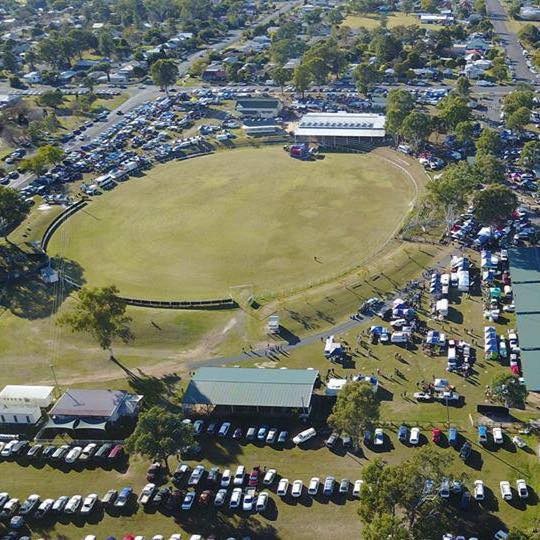
Nanango Showgrounds today, courtesy of Nanango Show Society
In 1997, Peter Warner, the race director, contacted the International Association of Ultrarunners to suggest that the event could host an International Track Championships. This was agreed and the race attracted “a stellar field” of 16 runners from Eastern Europe, New Zealand, Australia, Great Britain and Spain7.
In the late 1990s, there were at least three 1000 miles races in existence: Nanango, the 1000 Mile Stadium Run in Odessa8 and the Sri Chinmoy Ultra Trio 1000 Mile Race9.
The race began at midday on Wednesday 11th March and had a fifteen day cut-off, ending at midday on Thursday 26th March. It was held at the Nanango Shire Showgrounds. A circular gravel track measuring a quarter of a mile (440 yards, just over 400 metres) was built for the race. A 100-metre-long awning was erected to provide shade along one side.
The 1994 and 1996 races had been held at the Football Oval but this was reported not to be available due to Queensland Rugby League restrictions.
Andy Milroy, IAU Technical Director, had promoted the race globally. He gave the race organisers technical advice when needed by email. Andy Milroy received daily reports on the race’s progress and published short daily updates on the Ultramarathon World website. After the event had ended, he wrote a longer report with the results which was published in several places. Much of the detail in this article comes from that report.
Male competitors at the Nanango 1000 Mile Track Race
The fifteen male competitors included:
Petras Silkinas, Lithuania – holder of the world 1000 mile track record.
Tony Rafferty, Australia – the previous holder of the record.
Vladimir Glazkov, Russia – had won the 1000 Mile Stadium race in Odessa in 1996.
Bryan Smith, Australia – one of the few men to have covered 1000km in 6 days on the track.
Alfredo Uria, Spain – finished second to Gary Parsons in the Nanango 1000 Mile Race in 1996.
Cliff Young, Australia – winner of first Sydney to Melbourne race, an Australian ultrarunning celebrity, and the oldest competitor at 76.
Gary Parsons, the winner of the two previous races, was unable to attend due to a recent operation.
Female competitors at the Nanango 1000 Mile Track Race
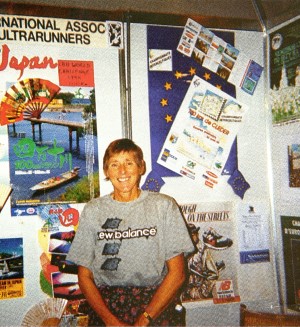
Eleanor Robinson at the IAU stand at the London Marathon Expo in April, IAU Newsletter, June 1998
The race preview on the Australian Coolrunning website10 stated that Sandra Brown and Catherine (Dipali) Cunningham would be competing but by the end of January both had withdrawn. Cunningham had won the Sri Chinmoy Ultra Trio 1000 Mile Race in 1997 setting a 1000 mile road world best. Silvia Andonie of Mexico was mentioned by Peter Warner as another potential participant11. She had run the second best 1000 mile track performance of 1997 in Mexico. However, in the end the only female competitor was Eleanor Robinson.
Robinson’s runner profile for the race described her as follows:
Eleanor Robinson – British. Sports Teacher/Youth Leader. 1989 world track record 24 hours Melbourne. 1990 world champion 100km (USA) and 24 hours (GB). 1991 world champion 100km (Italy). 1997 world indoor record 48 hours (Czech Republic). Married with 3 grown-up children, 6-year-old son.
Robinson was a veteran of Australian multi-day ultrarunning, having won the Colac 6 Day Race five times and the Westfield Sydney to Melbourne race (circa 620 miles) three times between 1984 and 1989. After the birth of her son, Myles, in 1991, Robinson raced mainly in the UK and Europe. She only raced in Australia once, the Telecom Tasmania 7-day stage race in 1994.
The cost of flights meant that Robinson could not afford to pay for a crew member to travel with her. Her friend Christine Perry, a physiotherapist from Melbourne, Australia, agreed to crew for her. Perry had supported Robinson on several of her Australian ultras. Nanango residents also provided support to the runners as many had been unable to bring their own crew.
Media coverage
In 1998, the internet was still only seven years old and only 9% of UK households had internet access12. Access was via dial-up using the home phone line and it was slow.
Most communication was still by phone, letter and fax. Eleanor Robinson and her husband Nigel did not have internet access and all the pre-race communication with the race organisers in Australia was by fax.
Despite the internet’s relative newness, people around the world were able to follow the race’s progress on running websites.
Melanie Jonker, a member of the Australian Ultra Runners Association (AURA) from Brisbane, attended the first weekend of the race. She phoned the organisers every afternoon for the latest lap counts and emailed daily updates on the race’s progress to a wide audience.
“The interest generated was quite overwhelming. Some people couldn’t believe it possible that a human could actually run 1000 miles over a period of 15 days (and shorter). Others followed the race on a daily basis with “baited breath”. Others sent congratulatory messages which I forwarded to Nanango. Others were so excited because they had actually met some of the runners in prior events13.”
Daily updates were posted on the Australian Coolrunning website by Jane Erkens and Melanie Jonker. These gave the results at the end of each 24 hour period/day, news of withdrawals, the weather and records set. Canadian David Blaikie’s Ultramarathon World website was also a source of news about the race and Runner’s World magazine’s daily news email carried updates.
People were encouraged to send messages of support for the competitors via the Ultramarathon World website and via email to Erkens and Jonker. Messages were also faxed. These messages were relayed to people at the trackside who read them out to the competitors. Nigel Robinson sent several faxes during and after the race to Peter Warner with messages for Eleanor. Nigel and Eleanor also managed to speak on the phone on a few occasions during the race. Nigel was mainly reliant on phone calls and faxes from Andy Milroy with details of what was happening day by day.
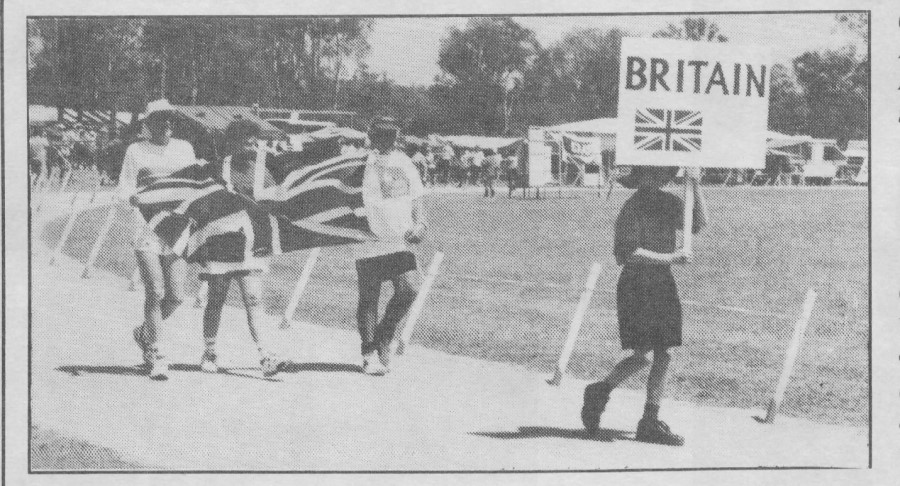
Calista Walters of St Patrick’s carries Britain’s banner onto the track for Eleanor Robinson, The Adviser, souvenir cover
The race start
A local paper, The Adviser, produced a Souvenir Cover. This reported on the start of the race and encouraged local residents to go and support the runners.
“The spectular opening ceremony at 11.30am was witnessed by an estimated crowd of 1000 in a very festive atmosphere. The 16 runners representing nine countries entered onto the track behind their flag and each national anthem was played as they walked up the area in front of the under-cover area where the crowd gave them many rousing cheers.”
The Nanango High School Band and the primary school choir entertained the crowd before the race began.
Peter Warner thanked the Nanango Shire Council, numerous sponsors, the Joint Telecommunications School of Cabarlah and the public for helping the race to go ahead. Before the race started there was a procession with flags of each of the countries represented.
An advertisement encouraged people to come and have refreshments or a meal at the showground bar and watch the race from there (presumably air-conditioned).
The race was started with the crack of a whip by the Nanango Mayor, Councillor Reg McCallum.
Pitiless, broiling sun
According to Andy Milroy, Petras Silkinas was the only one of the Northern Hemisphere runners who had had time to acclimatise, having arrived two weeks before the start. The others arrived two days before the start and had to acclimatise during the race. Robinson had always struggled with racing in the heat and this race was no different, as she explained in an interview with the Yorkshire Post published in May 199814.
“What worried me most was the heat; it took me several days to acclimatise and on the second days I threw up regularly for about 12 hours, which left me dehydrated and weak. I had hoped to do 100 miles a day…but because I was so ill I only did 65 on the second day.
Not that she even thought about stopping. “Well you throw up and then keep running, don’t you? It had cost a lot of money to go all that way so I didn’t intend to give up on the second day.”
The race started on a “a typical hot Queensland autumn day” The temperate was around 30 degrees Celsius with a light breeze, but during the race a heatwave built with high humidity and temperatures reaching 38 degrees in the shade by Day 4 (14th March). It may have been as much as 10 degrees higher on the exposed sections of the track.
The temperature only began to drop at around 6pm each day.
Sunburn became a problem. Andy Milroy reported that some of the runners resorted to wearing large brimmed hats and light weight pyjamas with holes cut in them for protection from the sun.
“The race was becoming a three way battle, against the distance, against fellow competitors and against the pitiless, broiling sun.”
Local residents supported the runners by coming down to the track with chilled watermelon and flavoured ice blocks. An article in a local paper at end of Day 5 (16th) reported that “some runners had been sneaking off to the Nanango pool in a bid to cool down while a couple had been having baths in ice15.” Competitors had been allowed to bed down under the grandstand as they were having trouble sleeping in the heat.
Robinson was given a caravan to sleep in but found it too hot. A woman who lived on the other side of the track offered her a space to sleep. The houses were on stilts with storage space underneath and Robinson took her remaining sleep breaks on a mattress under the house.
“Up to this point I had always regarded the Death Valley race as the worst physical conditions I had encountered but that race was a mere 146 miles. Relief from the sun came at night but it was then very humid. I took my main rest break during the hottest part of the day when I couldn’t bear to be outside16.”
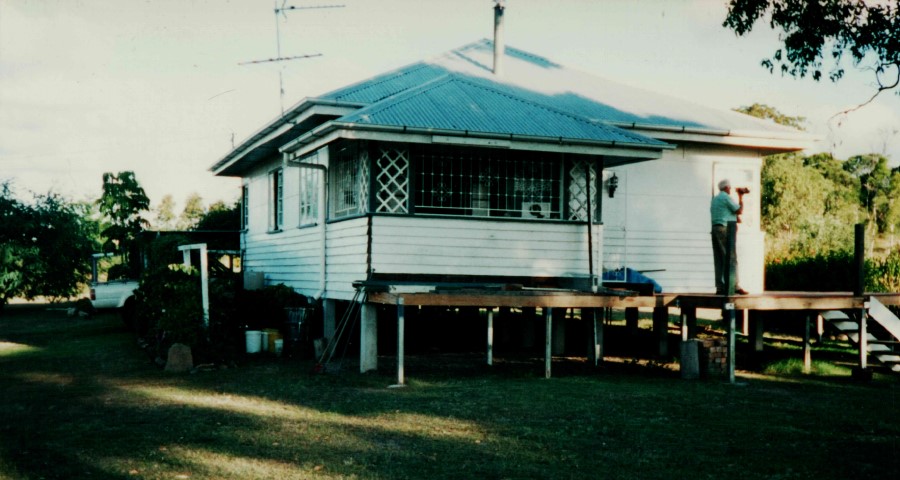
A typical house in the Nanango area, courtesy of Pat Wilson
A tropical storm and torrential rain
On Day 7, 17th March, there was a dramatic change in the weather.
“The unusually humid weather finally broke briefly. A fierce tropical storm swept through the area. The typhoon’s strong winds bent trees at right angles, and flooded much of the race area with torrential rain. The entire roof of the local Football Clubhouse was ripped off and dumped in a nearby creek.
During the torrential storm, Eleanor Robinson was out on the track. The tremendous wind seized the awning that shaded the track, and the whole structure was about to collapse. Graham Watts [a fellow competitor] grabbed the British runner and pulled her out of the way. No one was hurt, but from then on, when the sun returned in full force, there was no shade on the track. Unfortunately, once the storm had passed the heat did indeed return. By now even Queenslanders were complaining about the heat.”
Robinson described this as “a terrifying experience”.
A local newspaper on 20th March reported that the storm had ripped the roof off the Nanango Rugby League clubhouse. It also mentioned that the shade cloth provided for the runners at the Showground had been “torn apart and ruined17”.
The Nanango 1000 mile race day by day
This account is mainly taken from Andy Milroy’s detailed report on the race:
At end of Day 1 – Robinson was having some stomach problems but completed 100 miles and was in 8th position. Bryan Smith was in the lead in men’s race.
Day 2 – Robinson continued to have stomach problems and ran only 66 miles 1320 yds dropping one place to ninth. Smith passed 210 miles. Dusan Mravlje was about 8 miles behind him.
Day 3 – Robinson reached 242 miles. She seemed to have recovered from the stomach problems and was now back in 8th position. Dusan Mravlje dropped out. Smith was still in the lead with 295 miles, 16 miles ahead of Silkinas.
Day 4 – “Perhaps the problems experienced by Eleanor Robinson earlier in the race had had a beneficial effect upon her. She was obliged to run at a slower pace than she would have liked until her stomach had settled down and this reduced pace may have saved her problems in other areas. Whatever the reason she appeared to be stronger and was running comfortably moving into 6th position with 317 miles and only 10 miles behind the 5th placed runner.” Tony Rafferty retired.
Day 5 – race director Peter Warner was predicting that Robinson was going to smash the world track record and there was a good chance she would break the world road record too.
“We don’t want to put any pressure on her but she is in good spirits, looks strong and is making every post a winner18.”
Day 6 – Robinson was now 5th with 473 miles. Smith was still in the lead.
Day 7 – Robinson was still running well and in 5th position with 552 miles, only 4 miles behind Peter Gibson. Silkinas took the lead from Smith. Alfredo Uria retired.
Day 8 – Robinson overtook Peter Gibson moving into 4th place, behind Silkinas, Smith and Vladimir Glazkov. She finished the day with 619 miles and was well on schedule for a World Best Performance.
Day 12 – Robinson reached 902 miles at the end of Day 12. Silkinas had increased his lead over Smith and both he and Smith finished under 12 days and within the previous world best. Smith set an Australian national record. Vladimir Glazkov was still running.
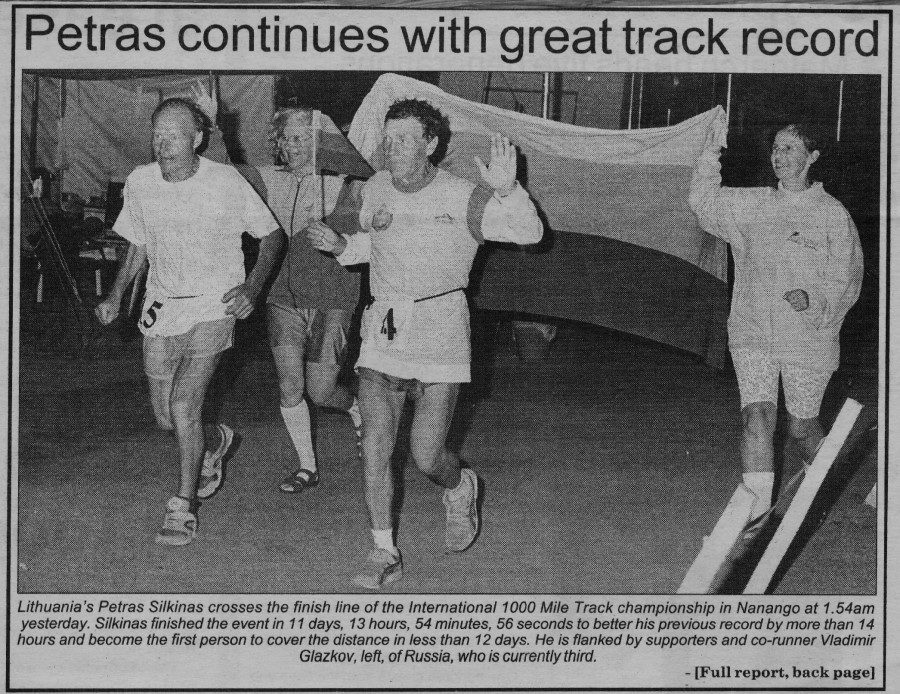
Newspaper clipping, Eleanor Robinson’s personal papers. Probably from South Burnett Times which had extensive coverage of the race.
Stress fracture
With just over 100 miles left to run, Robinson experienced an injury which could easily have put her out of the race. A stress fracture in her left shin led was compounded by torn thigh muscles in her right leg. Whilst Robinson admitted that in any other circumstances, she would have withdrawn from the race, she had not intention of stopping this time.
“Having done 896 miles, there was no way I wasn’t going to finish. I wasn’t going to go back and do it again. And I knew if I didn’t finish it, I’d have to go back19.”
Icing the injured shin every hour enabled her to continue but the last 24 hours were very painful. “It got to the stage…when even my hair hurt”20.
“Constant icing and a makeshift wedge put under my toes to alleviate pressure on the front of the injured leg allowed me to hobble to the finish.”
Surprisingly, after describing Robinsons’s injuries, Andy Milroy commented that “compared to most of the field she was in a reasonable shape, and was determined to finish.”
Day 13 – Vladimir Glazkov finished in a personal best time in third place.
“With the first three home, Eleanor Robinson was now the race leader. The rest of the runners left in the race no longer ran through the night, so she was left with the tough psychological task of battling alone through the darkness without anyone else on the track.”
1000 mile world best
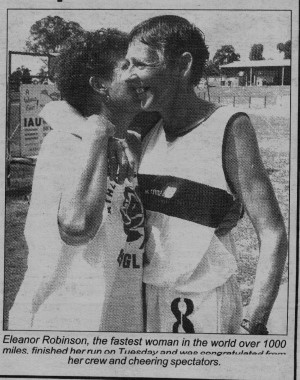
“World champ can now rest”, South Burnett Times, 27th March 1998
On Day 14, 25th March, Robinson finished just before 2pm in 13 days, 1 hour, 54 minutes and 2 seconds, reducing the world track best for women by 32 hours 54 minutes and 19 seconds. She had hoped to finish in under 13 days but her injuries had rendered that target impossible.
A local newspaper, the South Burnett Times, reported that, after celebrating briefly and having photos taken, Robinson had completed twelve more laps after finishing her run, in case of any errors in lap scoring21. She is quoted as saying:
“I didn’t think I was coming all this way to suffer, all I’m thinking of just now is a good cup of tea, a bath and a long sleep. I feel as though I haven’t slept for two weeks.”
Interviewed by the Independent on Sunday in April 1998, she remarked:
“Undoubtedly it’s the hardest thing I’ve ever run…not just for the sheer length of it but because of the conditions.”
When asked by the IAU to nominate the top ten ultra performances of her career, Robinson gave the Nanango 1000 Miles Track race the top spot in her list22.
I had accumulated many records en route and had given my all in pursuit of a dream. The pleasure and sense of achievement were immense. This has to be my number one performance.
24 years later, Robinson’s performance remains the world best women’s time for 1000 miles track and is the v50 age category record for 1000 miles on any surface (either road or track)23.
The final day of the race
Day 15 – Georgs Jermolajevs, Rustem Giniatullin and Peter Gray all finished with the cut-off. Three other runners were still on the track but had not completed the distance: Vladimir Vasiutin (over 940 miles), Aldo Maranzina (780 miles) and Graham Watts (over 767 miles).
“We have truly witnessed marvellous things”
Peter Warner, the race director, ended the race report in the IAU Newsletter with these words:
“The over-riding feeling expressed during the final ceremonies was one of mankind’s indomitable spirt; the ability to rise the occasion; to go “beyond the marathon”. Beyond all limitations and expectation of one’s self – equally true for runners, crew, lapscorers and the community at large.
Records have been broken, hearts have been changed forever and friendships formed. By public endorsement, Nanango is ready for the challenge of the new millennium ultra-distance series.
We have truly witnessed marvellous things.”
Sources
With thanks to Andy Milroy for sending me his article “Nanango: the toughest ultra race”, initially published on the Ultramarathon World website. Versions of the report appeared in the IAU newsletter June 1998, Road Runners Club newsletter, AURA Ultramag June 1998 and no doubt in other publications.
Thank you to Eleanor Robinson for lending me Road Runners Club and IAU newsletters, and allowing me access to her personal papers relating to the race.
The main sources for this article are:
- Andy Milroy’s article
- Interviews conducted by me with Eleanor Robinson in June 2018 and July 2021
- Eleanor Robinson’s personal papers
The banner photograph is from The Adviser souvenir cover and shows some of the competitors just after the start of the race. They are: 9 – Peter Gray, 8 – Eleanor Robinson, 2 – Tony Collins, 11 – Bryan Smith, 10 – Georg Jermolajevs
Footnotes
- In 1989, Eleanor Adams was one of six “outstanding record holders” selected for the Guinness Book of Records Hall of Fame, in recognition of the numerous world records she had set at ultrarunning for distances of 30 miles to 1000 miles. The Guinness Book of Records 1990.
- Eleanor Robinson competed in a 48-hour track race in Dallas, Texas, on 27th November 1997, a week after her 50th birthday but was forced to withdraw due to an inury after 24 hours. Dallas Ultrarunners/Plano Pacers 24h/48h, Mary Ann Miller, Ultrarunning magazine,
- The New Balance Challenge, 1000 mile stage race, reported in RRC newsletter August 1987 and IAU newsletter 1987. The time is that given by Andy Milroy in the IAU newsletter. It was slightly faster than the time given by Malcolm Campbell in his report in the RRC newsletter.
- Results of the runners that finished within the cutoff times for the 1994 and 1996 races are available on the Deutsche Ultra Marathon Vereinigung e.V website.
- In the race advertisement in the AURA Ultramag March 1998, Peter Warner stated that this was “Australia’s first ultra marathon international championships”.
- Georgina McConnell set Australian national records for 1000km and 500 miles at the 1996 race (AURA Ultramag March 1998). She competed against Eleanor Robinson in the 1989 Melbourne 24 Hour Track Race and the 1994 Telecom Tasmania 7 Day Stage Race.
- “Stellar field”, Andy Milroy.
- The 1000 Mile Stadium Run Odessa was held in 1995, 1996 and 1997. Results (DUV).
- The Sri Chinmoy Ultra Trio event in New York offered runners the opportunity to run 700, miles, 1000 miles or 1300 miles. It ran from 1985 to 2004.
- The Coolrunning website no longer exists, but can be accessed via web archives.
- Eleanor Robinson’s private papers.
- https://www.webselect.net/blog/the-internet-in-1998
- “Nanango Musings”, Melanie Jonker, AURA Ultramag June 1998
- “So here’s to you, Mrs Robinson…”, Richard Rae, Yorkshire Post, 9th May 1998.
- “Runners still on track to smash world records”, newspaper cutting (without date or newspaper name) from Eleanor Robinson’s private papers.
- Interview with Eleanor Robinson, 12th July 2021
- “Storm rips roof from clubhouse”, Friday 20th March, newspaper cutting from Eleanor Robinson’s private papers.
- Day 5 progress, “Runners still on track to smash world records”, newspaper cutting.
- Interview with Eleanor Robinson, June 2018.
- Yorkshire Post.
- “World champ can now rest”, South Burnett Times, 27th March 1998
- IAU Newsletter, March 2001
- 1000 mile records The IAU no longer distinguishes between surfaces when awarding world records. It therefore lists Sandra Barwick’s time as the 1000 miles world record. Barwick is the only woman to have run 1000 miles in under 13 days. Barwick set her time at the age of 41 during the 5th Sri Chinmoy Ultra Trio 1300 Mile Race in New York. This was a road race run on a one mile loop at Flushing Meadow Park, Queens, New York. Her 1000 mile split was 12 days 13 hours 48 minutes 40 seconds.
Full list of competitors and results
Read about the other performances that Eleanor Robinson nominated for her top ten list
1984 New York 6 Day Race
1984 Colac 6 Day Race
1986 Westfield Sydney to Melbourne Race
1987 The first Badwater Race
1989 Melbourne 24 Hour track race
1990 IAU International 24 Hour Championships Milton Keynes
1990 & 1991 IAU 100km World Championships
1994 Telecom Tasmania Run
and another race that did not make it into the top ten:
1983 The first Spartathlon
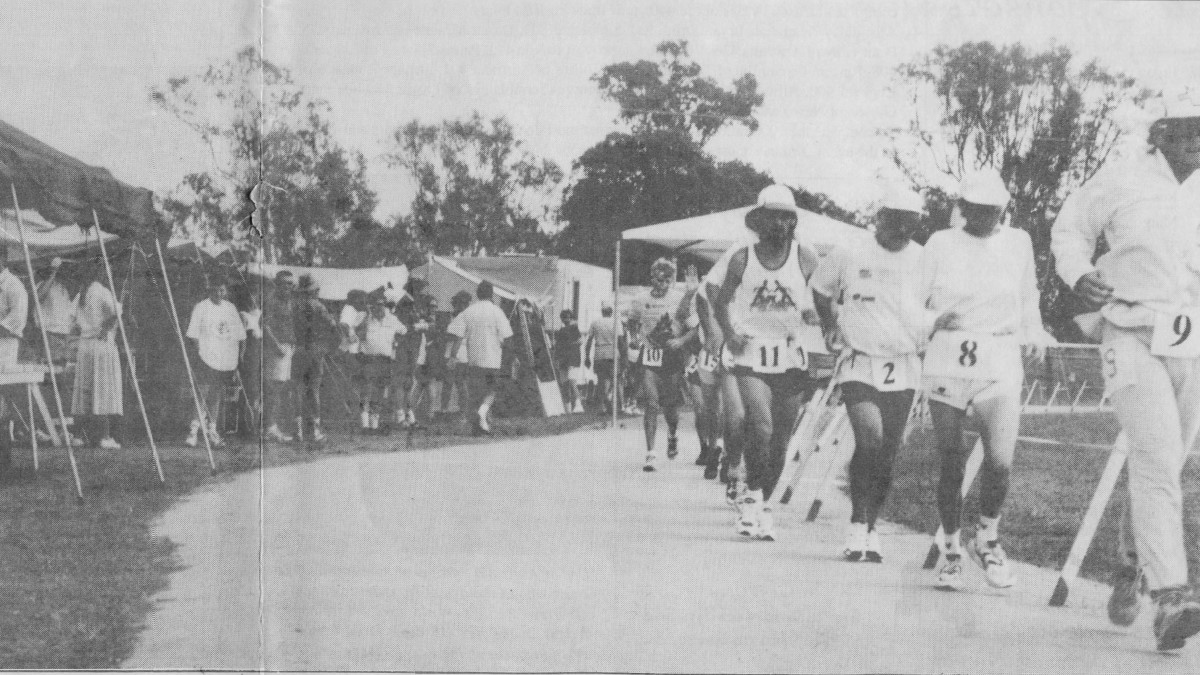
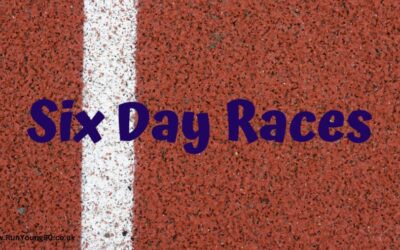
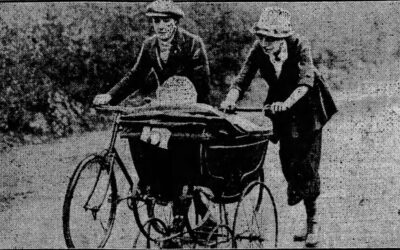
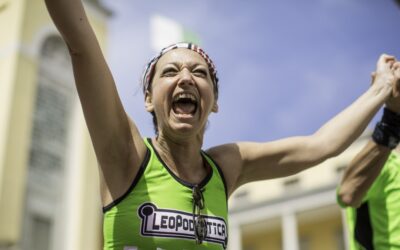
0 Comments